Porcelain Insulator News
by Jack H. Tod, NIA #13
Reprinted from "INSULATORS - Crown Jewels of the Wire", May 1983, page 24
Dear Jack:
The utility I work for
has had an interesting way of using the split knob types of "tree"
insulators. As I have sketched here, these were used for stringing the wire from
the pole to light fixtures over the center of the road. Old-timers here said
that when the large carbon arc lights were replaced with incandescent lamp
fixtures in the 1910's and 1920's, the messenger wire, heavy conductor and
supporting insulators were left alone. Only the fixtures were converted. Most of
these (about 15 remain) are being replaced now by new fixtures with high
pressure sodium luminaries on conventional modern brackets.

The old forestry
insulators I have acquired from these arrangements are marked "F",
"G" and an occasional "P.P. Inc." (appearing not quite so
old) in the bunch. I have also found a few split round ones with Thomas
markings.
Joe Maurath, Jr.
North Abington, Mass.
- - - - - - - - -
Dear Joe:
The "F" is
for Findlay Electric Porcelain Co. (Ohio, 1911-1927). The "P.P. Inc."
is for Porcelain Products, Inc. (W. Va., 1927-1956). If your utility still has
its Ca-1920 purchasing records, maybe you can tell us who used the "G"
marking. I still refuse to go out on a limb and attribute the "G" to
either Globe Porcelain or General Porcelain Co.
Jack
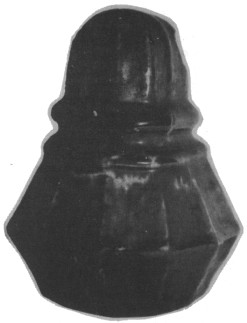
Dear Jack:
Enclosed are
photos and dimensional data of a new Bennington type threadless which is very
similar to the known U-982 style, but this insulator has a round dome and the
twelve-fluted feature unique to the Elliots. I wonder if this ties the so called
Bennington U-982 with the Elliots? Can you help with your opinion on this?
As
far as I know, this insulator was found by a bottle man in southeast
Massachusetts. I will have the insulator at the NIA National in Rochester.
John
de Sousa, NIA #419
East Granby, Conn.
- - - - - - - - - - -
Dear John:
Many thanks for your report of
this super new find. Yes, this could be the key information we've been seeking
for years, and it could tie five different threadless insulators to Bennington
Pottery. This should probably be ranked as "find of the year" without
even waiting for the year to end. This new item will be U-983 in the Universal
Style Chart.
This specimen is a definite hybrid of the U-982 (so called)
Bennington and the three Elliot varieties U-979, U-980 and U-981.
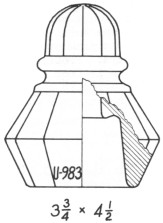
It has the
same overall shape and the same "Bennington type" glaze as the U-982.
That insulator had a possible attribution to Bennington Pottery because of its
distinctive glaze and some old museum-connected documentation accompanying the
discovery of the first U-982 specimen.
This U-983 has the twelve-flute exterior
feature of the Elliot designs and a rounded crown somewhat like the U-979. The
Elliot designs have a possible Bennington attribution because of their stoneware
nature, and also because of a pictorial recording of their inclusion in the
Bennington Pottery exhibit at an 1853 trade fair.
We are usually overcautious
about requiring some positive proof of facts before making unqualified
attributions of insulator styles or markings, but that is a difficult chore on
these very early antiquities. I do think we now have sufficient evidence to say
that all five of these threadless insulators were definitely a product of
Bennington Pottery.
Jack

I recently asked Ohio Brass Co. (Ohio) if they had any
file records to show the reason for the coding notches once used in the older
recess-embossed marking devices. Their reply:
"The significance of the side
notches in these markings is unknown. File paperwork on insulators does not go
back to the period when those insulators were manufactured."
I also
periodically query O-B about the use on pin type insulators of their current
"logo" adopted in 1972 (bottom marking shown above). Their reply on
that:
"O-B pintype insulators are still marked with the B-within-the-0
logo. In recent years, numbers representing month (first number on the left) and
last two digits of year appear below the B within the 0."
We would like to
hear from someone who has a specimen with this dated Monogram-OB marking --
whether the numbering is with raised numbers or what. A foil impression would
help.
To make and mail perfect foil impressions of markings of embossed
varieties, cut out a small piece of new, unwrinkled foil and hold it over the
marking so it won't slide around. Now repeatedly press all over the foil hard
with the rounded eraser on a pencil until the marking is sharply brought up into
the foil. Lay the foil upside down and pour a puddle of Elmer's glue over the
marking area, and let it dry a couple of days. Pre-fold your letter to fit your
envelope; then remove it from envelope and tape one tip end of the foil to the
letter in a spot where it will end up on the bottom part of the envelope away
from the canceling roller.
Jack

In the April issue, we reported that the Victor,
N.Y. insulator plant is now owned and operated by Brown Boveri Electric, Inc.
and uses a marking of BBC. We made a second inquiry to the company to decode the
marking, and they said that the marking stands for "Brown, Boveri and
Company", the parent company of the subsidiary Brown Boveri Electric.
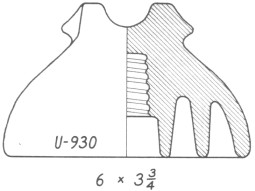
Dear
Jack:
I am enclosing photos and dimensioned drawing of a 6" Imperial
Porcelain Works item unlike any presently in the Universal Style Chart, and
would this be a new one for the Chart? It has all petticoats flush with the
skirt, and it is not a glazeweld. The ears are about double the width of the
similarly styled units such as U-929.

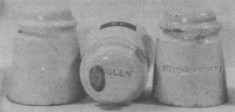
The other photo shows three different
white glaze Fred Locke ponies, all the dainty U-38. The middle one clearly shows
the incuse 'GLEN' marking you may have known about. The black spot on the crown
is a firing blemish. There must be several specimens of this marking known,
since Gerald Brown shows one in his book with the marking on the edge of the
crown instead of on the flat top.
Elton Gish, NIA #41
Port Neches, Texas
- - - - - - - - -
Dear
Elton:
Without exception, all of the Imperial pin types are enough different
from styles of all other manufacturers as to be readily distinguishable as
Imperial, so it is important to have every one of them in the Universal Style
Chart to serve as specific references and to assist in attributing unmarked
specimens. This new one will be U-930.
In all these years, you are the first
collector who has ever confirmed this 'GLEN' marking to me or this magazine.
Just like the past "rumors" of its existence, I've also heard of at
least one guess at its attribution. If anyone can come up with concrete
information on that (wild guesses don't count), we'll report and record that
also.
Jack
Dear Jack:
I got some interesting lightning arrestors from a
communications line which is being wrecked. Most of the wires had already been
removed, so I couldn't tell how these were originally set up. The wordy embossed
(raised letters) marking on top of the porcelain case is:

(CRYSTAL VALVE
LIGHTNING ARRESTOR TYPE LC No 51081 0-750 VOLTS AC PT. No. 1783667)
Are you
familiar with the Crystal Valve name? It would seem to be unusual for a
lightning arrestor.
I also found some dead-end brackets and porcelain U-shaped
strain insulators, designed to fit the brackets. The brown-glazed insulators had
this recess-embossed marking:
RACO // DEAD END
Some of the brackets are marked
RACO. Who produced RACO?
The line being wrecked, in a few instances, used
Hemingray-56 glass transposition insulators as regular insulators, with a single
conductor tied in the upper wire groove. What made this set-up different was
that the ends of the of the wire formed a loop over the top of the insulator. In
the center of this loop was what appeared to be a small metal ball, probably
about 1/2" diameter. Was this a splice? I've seen this tie arrangement used
elsewhere with single-groove insulators. What is the purpose of it?
William C. Ogden, NIA #1857
Virginia, Minnesota
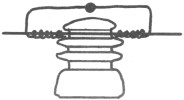
- - - - - - - - - - -
Dear William:
Yes, I am familiar with the
"Crystal Valve" arrestor, but I can't attribute it. If the sketch in
the middle of the marking is the keystone marking (as I drew it there), this is
the trademark of Electric Service Supplies Co., Philadelphia. If some collector
can't attribute this item by a cataloging, maybe someone near a large library
could attribute it by looking up the 1930 patent number shown in the marking.
The RACO dead-end insulators are known in collections, but I can't recall of the
name being attributed to any company. Your finding their use with the special
RACO brackets at least answers our question about the reason for the odd
configuration of these strain insulators.
I know nothing about the tie-wire
method you sketched, but maybe some of the CJ readers are familiar with it. If
so, we'd like someone to send us the answer about it.
Jack
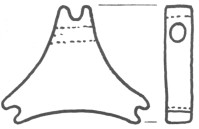
Dear Jack:
I have
three secondary messenger wire insulators, one brown one and two whites. All are
marked "PINCO / Lima, New York". The patent dates are too faint to
read. Are these considered scarce? They used to use quite a few here.
Steven
Jones
Naugatuck, Conn.
- - - - - - - - - - -
Dear Steven:
The patent on these items is #2,921,112 of
1/12/60, L. J. Dykstra assignor to Pinco, "Electric conductor strand
separator insulator". They are primarily used to separate the strands so
taps can be spliced to the through line.
It is not meaningful to evaluate these
as common/scarce/ rare. They would be very common in any utility area where they
are in ordinary use and naturally unknown in areas where they have never been
used. In collector circles, they would be commonly available if anyone took a
box of them to several insulator shows, and otherwise not often seen.
Insulator
collecting got its biggest boost years ago from association with bottle
collectors, and due to the pretty glass involved. There has always been a bias
favoring the glass ones for that reason, and more specifically to glass poleline
insulators because they have been most favored by intensive historical research
and good publications.
Porcelain pin types started to be collected after the
glass ones became collected as "insulators" instead of just
"pretty glass", and they had a parallel usage on pole lines. They
became a popular collectible only after considerable research led to publication
of good reference books on them.
But there is no end to porcelain insulators
other than pin types, so most collectors severely limit their scope of
collecting. As an oversimplified rule of thumb on collector interest and value
of a porcelain insulator, it has one strike against it if it won't screw onto a
crossarm peg, two strikes against it if it isn't used on a pole line, and just
about three strikes if its specific use isn't known.
Jack
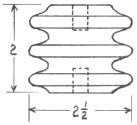
Dear Jack:
I have a small
insulator taken from a power and telephone line here in Minnesota (see sketch)
which has a blue-green glaze and an off-white body color. It is very heavy
(16-1/2 oz.) for its size. The 5/8" blind holes in each end have threads
for a 3/8" bolt. Could you tell me who made these and if it has any value?
Larry Larson
Hoyt Lakes, Minn.
- - - - - - - - - - -
Dear Larry:
I know nothing about who might have
made this insulator or its intended application. A calculation of its volume
together with the 16-1/2-ounce weight indicates that its made of Alumina
(specific gravity 3.7 versus 2.4 for electrical porcelain) which is a special,
high-strength ceramic.
I can't hazard a guess as to any possible collector value
of "whatisit" types of insulators.
Jack
| 